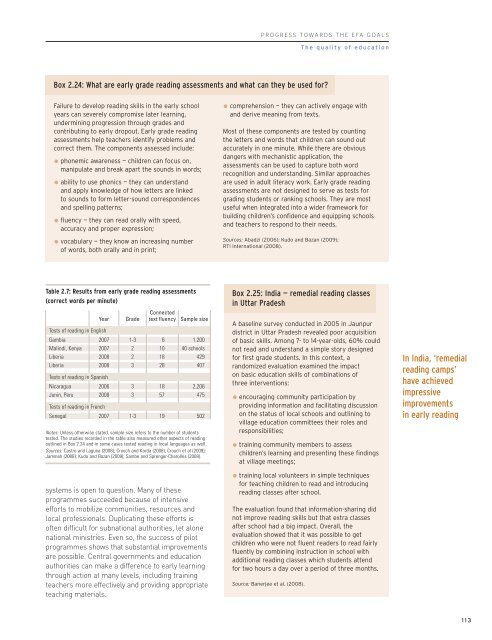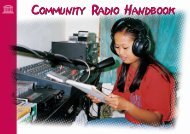Chapter 2. Progress towards the EFA goals - Unesco
Chapter 2. Progress towards the EFA goals - Unesco
Chapter 2. Progress towards the EFA goals - Unesco
You also want an ePaper? Increase the reach of your titles
YUMPU automatically turns print PDFs into web optimized ePapers that Google loves.
PROGRESS TOWARDS THE <strong>EFA</strong> GOALS<br />
The quality of education<br />
Box <strong>2.</strong>24: What are early grade reading assessments and what can <strong>the</strong>y be used for?<br />
Failure to develop reading skills in <strong>the</strong> early school<br />
years can severely compromise later learning,<br />
undermining progression through grades and<br />
contributing to early dropout. Early grade reading<br />
assessments help teachers identify problems and<br />
correct <strong>the</strong>m. The components assessed include:<br />
phonemic awareness — children can focus on,<br />
manipulate and break apart <strong>the</strong> sounds in words;<br />
ability to use phonics — <strong>the</strong>y can understand<br />
and apply knowledge of how letters are linked<br />
to sounds to form letter-sound correspondences<br />
and spelling patterns;<br />
fluency — <strong>the</strong>y can read orally with speed,<br />
accuracy and proper expression;<br />
vocabulary — <strong>the</strong>y know an increasing number<br />
of words, both orally and in print;<br />
comprehension — <strong>the</strong>y can actively engage with<br />
and derive meaning from texts.<br />
Most of <strong>the</strong>se components are tested by counting<br />
<strong>the</strong> letters and words that children can sound out<br />
accurately in one minute. While <strong>the</strong>re are obvious<br />
dangers with mechanistic application, <strong>the</strong><br />
assessments can be used to capture both word<br />
recognition and understanding. Similar approaches<br />
are used in adult literacy work. Early grade reading<br />
assessments are not designed to serve as tests for<br />
grading students or ranking schools. They are most<br />
useful when integrated into a wider framework for<br />
building children’s confidence and equipping schools<br />
and teachers to respond to <strong>the</strong>ir needs.<br />
Sources: Abadzi (2006); Kudo and Bazan (2009);<br />
RTI International (2008).<br />
Table <strong>2.</strong>7: Results from early grade reading assessments<br />
(correct words per minute)<br />
Gambia<br />
Malindi, Kenya<br />
Liberia<br />
Liberia<br />
Nicaragua<br />
Junin, Peru<br />
Year<br />
Tests of reading in English<br />
Tests of reading in Spanish<br />
Grade<br />
Connected<br />
text fluency<br />
Sample size<br />
2007 1-3 6 1,200<br />
2007 2 10 40 schools<br />
2008 2 18 429<br />
2008 3 28 407<br />
2006 3 18 2,206<br />
2008 3 57 475<br />
Tests of reading in French<br />
Senegal<br />
2007 1-3 19 502<br />
Notes: Unless o<strong>the</strong>rwise stated, sample size refers to <strong>the</strong> number of students<br />
tested. The studies recorded in <strong>the</strong> table also measured o<strong>the</strong>r aspects of reading<br />
outlined in Box <strong>2.</strong>24 and in some cases tested reading in local languages as well.<br />
Sources: Castro and Laguna (2008); Crouch and Korda (2008); Crouch et al (2009);<br />
Jammeh (2008); Kudo and Bazan (2009); Sambe and Sprenger-Charolles (2008).<br />
systems is open to question. Many of <strong>the</strong>se<br />
programmes succeeded because of intensive<br />
efforts to mobilize communities, resources and<br />
local professionals. Duplicating <strong>the</strong>se efforts is<br />
often difficult for subnational authorities, let alone<br />
national ministries. Even so, <strong>the</strong> success of pilot<br />
programmes shows that substantial improvements<br />
are possible. Central governments and education<br />
authorities can make a difference to early learning<br />
through action at many levels, including training<br />
teachers more effectively and providing appropriate<br />
teaching materials.<br />
Box <strong>2.</strong>25: India — remedial reading classes<br />
in Uttar Pradesh<br />
A baseline survey conducted in 2005 in Jaunpur<br />
district in Uttar Pradesh revealed poor acquisition<br />
of basic skills. Among 7- to 14-year-olds, 60% could<br />
not read and understand a simple story designed<br />
for first grade students. In this context, a<br />
randomized evaluation examined <strong>the</strong> impact<br />
on basic education skills of combinations of<br />
three interventions:<br />
encouraging community participation by<br />
providing information and facilitating discussion<br />
on <strong>the</strong> status of local schools and outlining to<br />
village education committees <strong>the</strong>ir roles and<br />
responsibilities;<br />
training community members to assess<br />
children’s learning and presenting <strong>the</strong>se findings<br />
at village meetings;<br />
training local volunteers in simple techniques<br />
for teaching children to read and introducing<br />
reading classes after school.<br />
The evaluation found that information-sharing did<br />
not improve reading skills but that extra classes<br />
after school had a big impact. Overall, <strong>the</strong><br />
evaluation showed that it was possible to get<br />
children who were not fluent readers to read fairly<br />
fluently by combining instruction in school with<br />
additional reading classes which students attend<br />
for two hours a day over a period of three months.<br />
Source: Banerjee et al. (2008).<br />
In India, ‘remedial<br />
reading camps’<br />
have achieved<br />
impressive<br />
improvements<br />
in early reading<br />
113
















